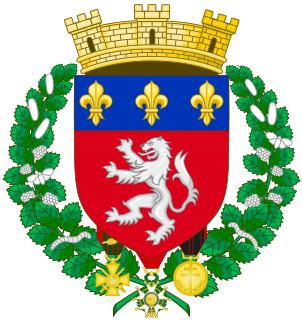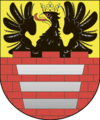
Heraldry is a discipline relating to the design, display and study of armorial bearings, as well as related disciplines, such as vexillology, together with the study of ceremony, rank and pedigree. Armory, the best-known branch of heraldry, concerns the design and transmission of the heraldic achievement. The achievement, or armorial bearings usually includes a coat of arms on a shield, helmet and crest, together with any accompanying devices, such as supporters, badges, heraldic banners and mottoes.

The coat of arms of France depicts a lictor's fasces upon branches of laurel and oak, as well as a ribbon bearing the national motto of Liberté, égalité, fraternité. The arms were created in 1905 by heraldic painter-engraver Maurice de Meyère, and adopted by the French government.

In heraldry, a charge is any emblem or device occupying the field of an escutcheon (shield). That may be a geometric design or a symbolic representation of a person, animal, plant, object, building, or other device. In French blazon, the ordinaries are called pièces, and other charges are called meubles.

Pierzchała (Roch) is a Polish coat of arms. It was used by several szlachta families in the times of the Kingdom of Poland and the Polish–Lithuanian Commonwealth.
Blason is a form of poetry. The term originally comes from the heraldic term "blazon" in French heraldry, which means either the codified description of a coat of arms or the coat of arms itself. The Dutch term is Blazoen, and in either Dutch or French, the term is often used to refer to the coat of arms of a chamber of rhetoric.

The lozenge in heraldry is a diamond-shaped charge, usually somewhat narrower than it is tall. It is to be distinguished in modern heraldry from the fusil, which is like the lozenge but narrower, though the distinction has not always been as fine and is not always observed even today. A mascle is a voided lozenge—that is, a lozenge with a lozenge-shaped hole in the middle—and the rarer rustre is a lozenge containing a circular hole in the centre. A field covered in a pattern of lozenges is described as lozengy; similar fields of mascles are masculy, and fusils, fusily. In civic heraldry, a lozenge sable is often used in coal-mining communities to represent a lump of coal.

In heraldry and heraldic vexillology, a blazon is a formal description of a coat of arms, flag or similar emblem, from which the reader can reconstruct the appropriate image. The verb to blazon means to create such a description. The visual depiction of a coat of arms or flag has traditionally had considerable latitude in design, but a verbal blazon specifies the essentially distinctive elements. A coat of arms or flag is therefore primarily defined not by a picture but rather by the wording of its blazon. Blazon is also the specialized language in which a blazon is written, and, as a verb, the act of writing such a description. Blazonry is the art, craft or practice of creating a blazon. The language employed in blazonry has its own vocabulary, grammar and syntax, which becomes essential for comprehension when blazoning a complex coat of arms.
Clément Prinsault was a 15th-century French heraldist.

René de Longueil, marquis (1658) de Maisons (1596–1677), le président de Maisons, was Surintendant des Finances under Louis XIV. He built the Château de Maisons.

The so-called Bars of Aragon, Royal sign of Aragon, Royal arms of Aragon, Four Bars, Red Bars or Coat of arms of the Crown of Aragon, which bear four red paletts on gold background, depicts the familiar coat of the Kings of Aragon. It differs from the flag because this latter uses fesses. It is one of the oldest coats of arms in Europe dating back to a seal of Raymond Berengar IV, Count of Barcelona and Prince of Aragon, from 1150.

In heraldry, a bar is an ordinary consisting of a horizontal band across the shield. If only one bar appears across the middle of the shield, it is termed a fess; if two or more appear, they can only be called bars. Calling the bar a diminutive of the fess is inaccurate, however, because two bars may each be no smaller than a fess. Like the fess, bars too may bear complex lines. The diminutive form of the bar is the barrulet, though these frequently appear in pairs, the pair termed a "bar gemel" rather than "two barrulets".
This page lists the armoury of the communes in la Manche.
This page lists the armoury emblazons, heraldic descriptions, or coats of arms of the communes in Nord (Q-Z)

A number of cross symbols were developed for the purpose of the emerging system of heraldry, which appeared in Western Europe in about 1200. This tradition is partly in the use of the Christian cross an emblem from the 11th century, and increasingly during the age of the Crusades. Many cross variants were developed in the classical tradition of heraldry during the late medieval and early modern periods. Heraldic crosses are inherited in modern iconographic traditions and are used in numerous national flags.
A national coat of arms is a symbol which denotes an independent state in the form of a heraldic achievement. While a national flag is usually used by the population at large and is flown outside and on ships, a national coat of arms is normally considered a symbol of the government or the head of state personally and tends to be used in print, on heraldic china, and as a wall decoration in official buildings. The royal arms of a monarchy, which may be identical to the national arms, are sometimes described as arms of dominion or arms of sovereignty.

Frédéric Rodriguez-Luz, also known as Frédéric Luz, is a French writer and heraldist. He is also the current pretender to the "throne" of the Kingdom of Araucanía and Patagonia, "an ephemeral 19th-century state." This has also been described as a "non-existent kingdom not recognized by any State" currently represented by a French non-profit organization dedicated to international campaigning on behalf of the Mapuche people.

The coat of arms of Lyon, the ancient capital of the Gauls, reflects the rich history of the city across different periods of its existence and the power that has exercised authority over the city. It was created in 1320, although the current version, which dates from 1859, reprises the form that it had before the end of the Ancien Régime after having undergone several temporary modifications.
This page shows the coats of arms, heraldic achievements, and heraldic flags of the House of Nassau.

Belgian Heraldry is the form of coats of arms and other heraldic bearings and insignia used in the Kingdom of Belgium and the Belgian colonial empire but also in the historical territories that make up modern-day Belgium. Today, coats of arms in Belgium are regulated and granted by different bodies depending on the nature, status, and location of the armiger.

National symbols of Belgium are the symbols used to represent the Kingdom of Belgium. Article 193 of the Belgian Constitution is dedicated to specifying the national flag, colours, coat of arms, and motto. It says the following: "The Belgian nation takes red, yellow and black as colours, and as state coat of arms the Belgian lion with the motto Unity makes strength."



















